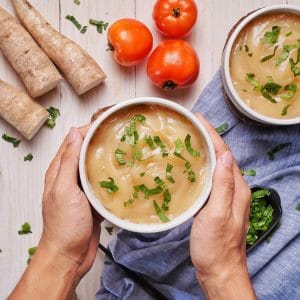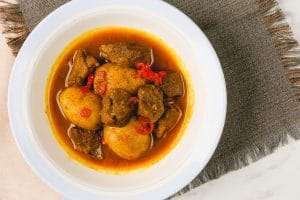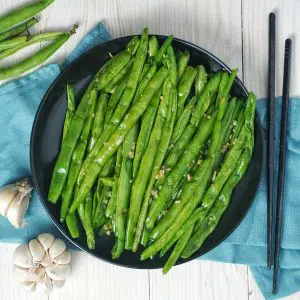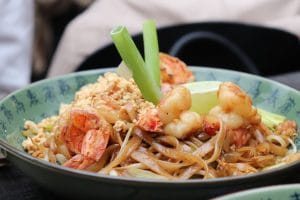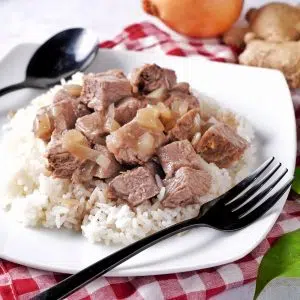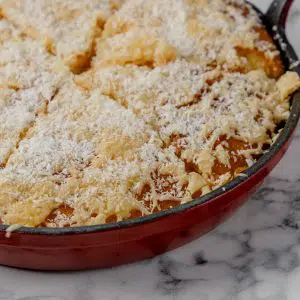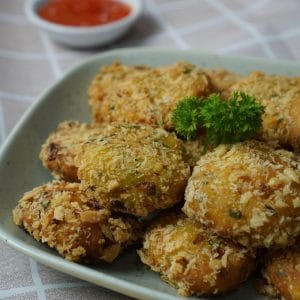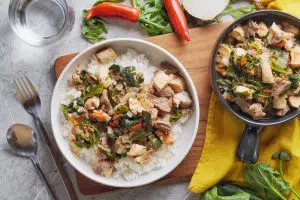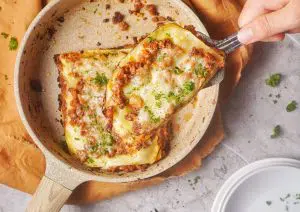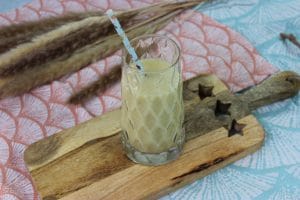Homemade Kung Bo Gai Ding
Important Note: When you buy through our links, we may earn a commission. As an Amazon Associate we earn from qualifying purchases. Content, pricing, offers and availability are subject to change at any time - more info.

Ingredients
- 1 lb skinless boneless chicken breasts
- 4 tsp corn starch
- 1 tbsp soy sauce
- 1 tbsp rice wine
- 1/2 tsp balsamic vinegar
- 1 tbsp brown sugar
- 1/2 tsp salt
- 1 tsp sesame oil
- 3 garlic cloves
- 4 scallions
- 1 tsp fresh ginger
- 3 tbsp vegetable oil
- 5 dry red chili peppers
- 1/2 cup roasted peanuts
Instructions
- Make sure you have all the ingredients or suitable substitutes ready.

- Chop the chicken into 1-inch squares and place in a medium bowl. Sprinkle 2 teaspoons of corn starch over the chicken and toss to coat. The goal is to have each chicken chunk covered in corn starch. Set this aside.
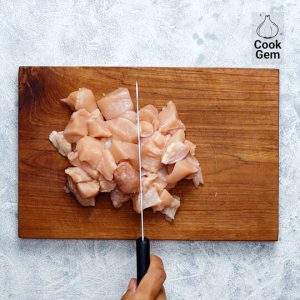
- In a small bowl, combine soy sauce, rice wine, vinegar, sugar, salt, and sesame oil. Whisk thoroughly until mixed, then set aside. Combine another 2 teaspoons of corn starch with 2 teaspoons of water in a new bowl and mix until combined, then set aside.
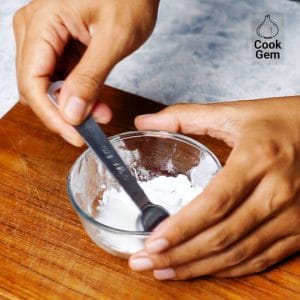
- Mince the garlic and chop the scallions and ginger to prepare for frying.
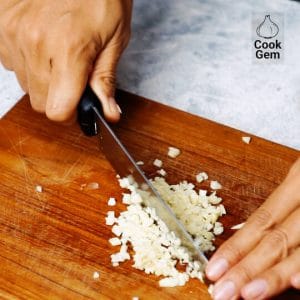
- Using a wok or large skillet, heat the vegetable oil over medium-high heat. Once the oil is hot, add the chili peppers. Stir and cook until the peppers have darkened. Add the garlic, scallions, and ginger and cook for about 2 minutes, or until fragrant.
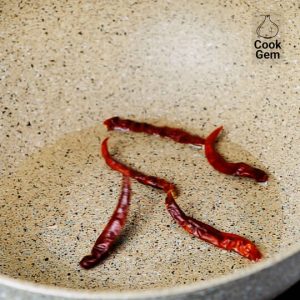
- Add the chicken to the skillet, making sure to stir so nothing sticks to the bottom of the pan and the chicken gets cooked on all sides. Cook for 5 minutes, or until the chicken is white and cooked through.

- Pour in the sauce and mix it into the chicken and vegetables before pouring in the corn starch-water mixture and stirring again. Continue stirring until the sauce begins to thicken, then add the peanuts and stir until everything is coated.
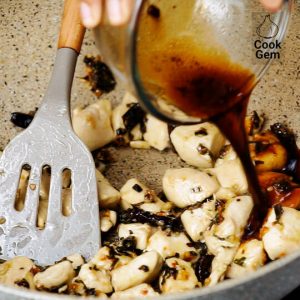
- Once all ingredients are coated and the sauce is thick, remove from heat and serve.
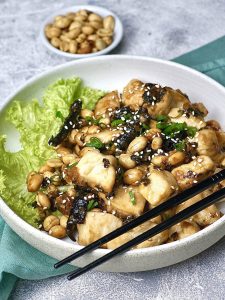
Video
Nutrition
You might think this is a dish you have never heard of before. But have you heard of kung pao chicken? Probably so. Kung pao chicken is another name for kung bo gai ding, though admittedly the kung pao name is a lot more popular in the US. The original dish comes from a province in south-central China called Guizhou. The dish immigrated to the United States and, under the moniker of kung pao chicken, has become one of the most well-known Chinese dishes in the US. Versions of kung bo gai ding can be found at fast food Asian fusion restaurants all across the country, and even in supermarkets like Wal-Mart.
This version is fairly spicy and also contains peanuts. If either of those factors put you off, I’ve written some adjustments below the recipe, or you can opt for a totally different kind of chicken. If you’ve tried this recipe and decided against it, why not give cinnamon coconut milk chicken a try?
Serving Suggestions
Kung bo gai ding is at its best when served on top of soft, steamy rice. I prefer to use jasmine rice for almost all my dishes, but you can use any rice you have on hand. Jasmine is my favorite because it has a good, versatile flavor that doesn’t overpower dishes and it can be easily made to be sweet or sticky, depending on what you need. It cooks well in a rice cooker (follow the instructions that came with the cooker), but if you don’t have one, you can make it on the stovetop.
For this recipe, you will probably want 3 cups of dried rice. I’m operating off jasmine rice rules here, but if you use a different kind you can look up what water-to-rice ratio you need. For jasmine rice, you should use a 1-to-1 rice/water ratio. Put your rice in a colander first and rinse it under cold water, moving the rice around so it all gets clean. This helps remove starch. Add the clean rice to a pot and add an equal amount of cold water (so, 3 cups of rice and 3 cups of water). Sprinkle a little bit of salt in. I usually add a tablespoon of white sugar too…but that’s just me. Cover and cook on medium heat for thirty or so minutes, or until the rice is light and fluffy.
If you want to add some color to your plate, you could try making vegetable spring rolls or some caramelised carrots. Or maybe all you need is a side salad with the leftover veggies in your fridge!
Modifications
If you want to make this dish, but you’re worried about the level of heat, you can easily modify the recipe to suit your tastes. Add less chili peppers, or even none at all. If you don’t have any chili peppers, but do want some heat, use chili paste or add dried chili flakes. If you actually prefer heat, but you’re serving people who are sensitive to heat, prepare the dish without much spice and then add homemade siracha to your plate.
If you are allergic to peanuts (or just don’t like them), you could substitute raw or toasted cashews. Cashews are a little meatier than peanuts, so they will change the taste, but they are still a nice addition. You can also substitute some of the meat with vegetable like celery or bok choy. Add those veggies to the skillet at the same time that you add the garlic.
If you have recently found yourself meat-free for any reason but miss the taste of your favorite kung pao chicken, make this recipe with tofu instead. Make sure it’s extra firm tofu and press it an hour before cooking to remove most of the moisture. You might want to cook the tofu on its own and add it to the pan more towards the end, after the sauce has started to thicken. That will help ensure that the tofu is still crisp by the time it reaches your mouth.
Notes & Tips
- If you have leftovers, you can store them in an airtight container in the fridge for up to 5 days.
- You can reheat this in a microwave, but be aware that any crisp the chicken had will probably be lost. If you have a little more time on your hands, you can reheat it in a pan over your stove and that will allow the chicken to crisp up a bit more.
